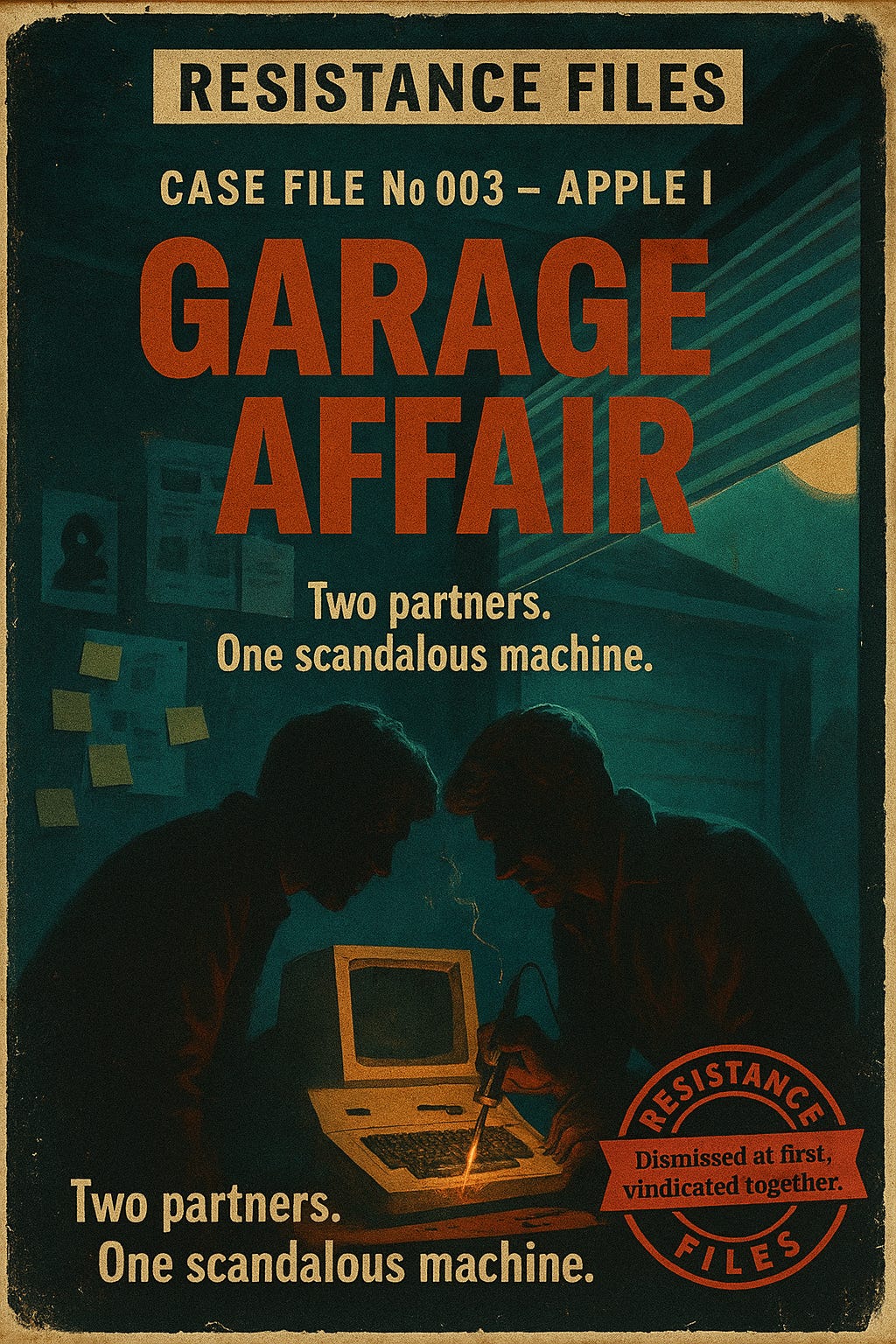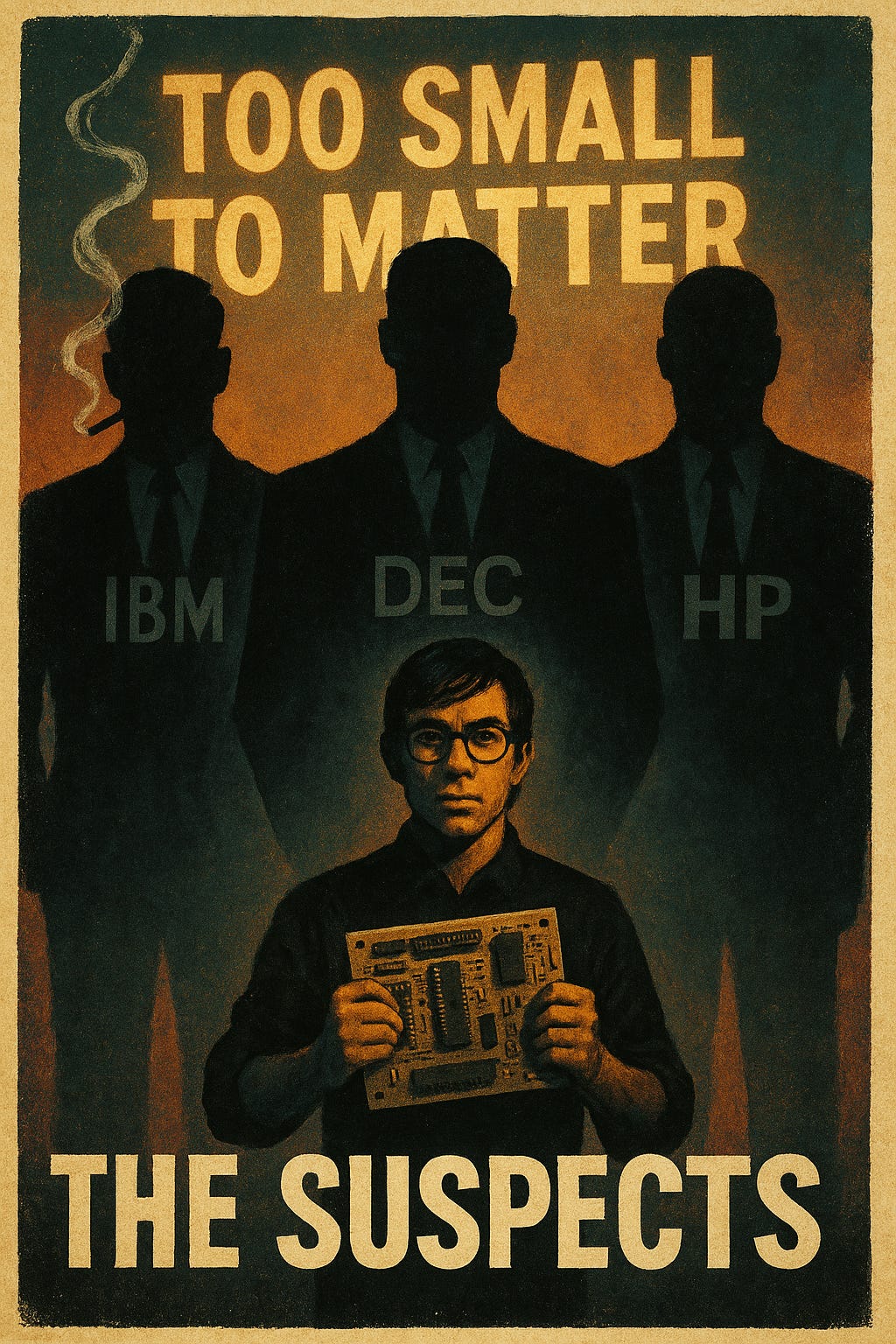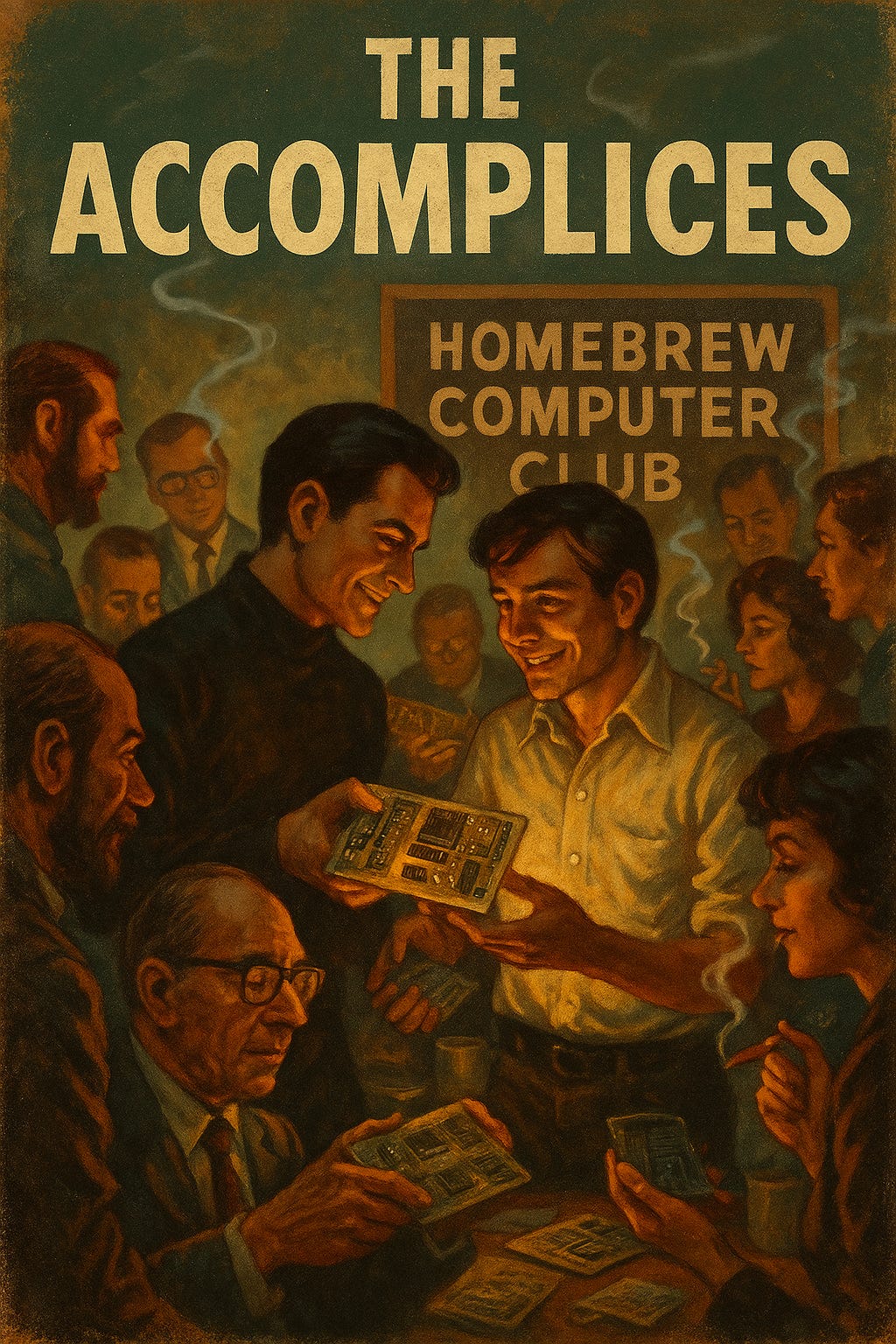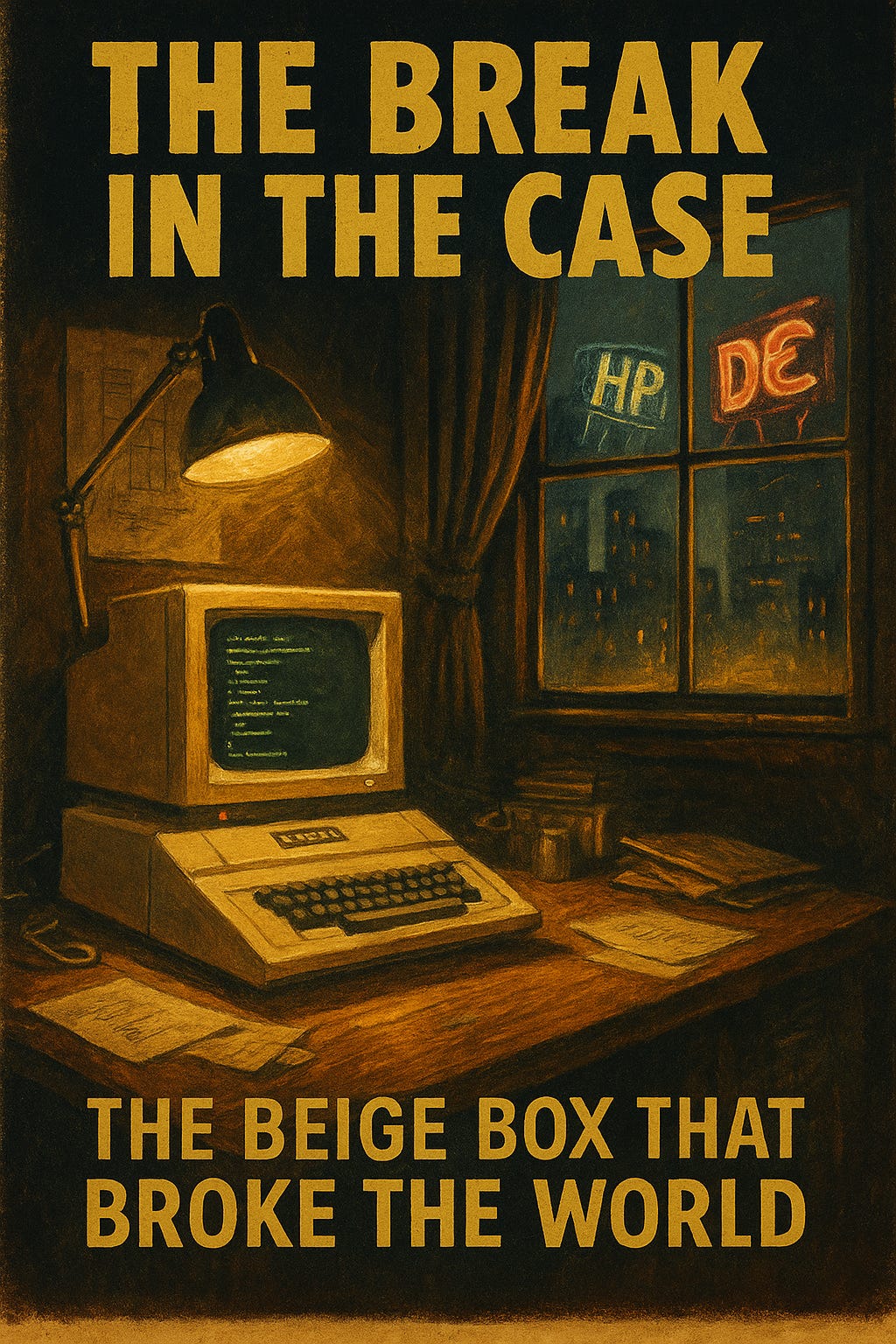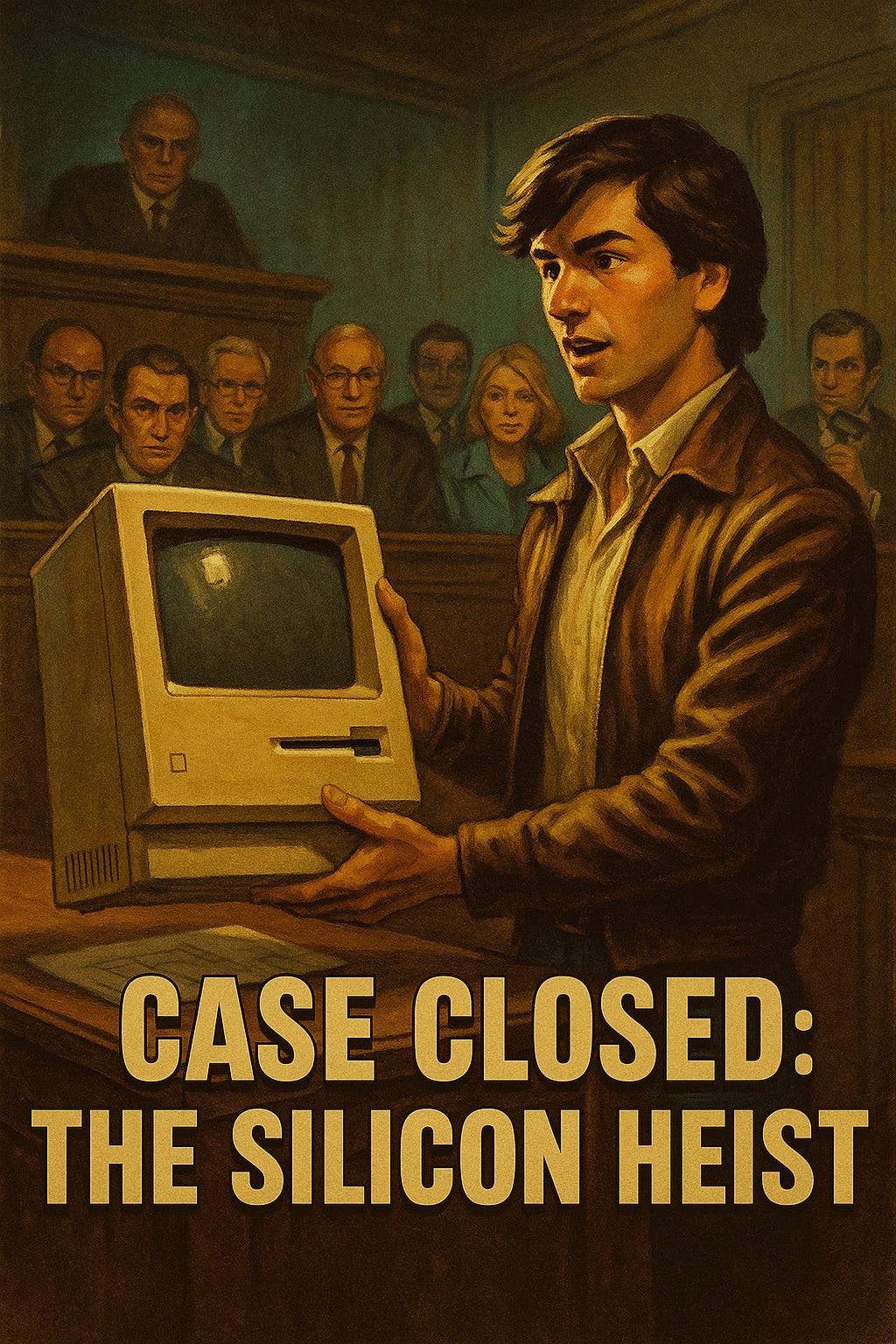Resistance Files: The Silicon Heist
Case File #003
Top of the Series: Resistance Files: The Unusual Suspects
Previous: Resistance Files: The Flop That Stuck Around
The Garage Affair
Dismissed as a hobby. Remembered as a revolution.
The Crime Scene
The garage smelled like burnt circuits and ambition. A cracked window, a naked lightbulb, two kids in jeans building heresy with a soldering iron.
They weren’t supposed to be here. The big machines lived in glass towers, guarded by suits and keycards. The idea that ordinary people might own one — that a computer could live next to a toaster — was madness.
But madness has a way of working nights.
Steve Wozniak was the engineer — soft-spoken, brilliant, the kind of mind that could turn a scrap heap into symphony. Jobs was the spark, barefoot and brazen, selling futures that didn’t exist yet. Together, they weren’t building a product. They were committing a crime against convention.
Across town, IBM polished its logo and yawned. Digital Equipment Corporation scoffed. The press called it a “hobbyist’s toy.” Investors crossed the street.
But inside that cramped Cupertino garage, a beige box flickered to life — a hum that sounded a lot like rebellion.
The neighbors thought they were tinkering.
They weren’t.
They were rewiring the world.
The Suspects
They called them dreamers, amateurs — kids with solder burns and big talk. The suits in the high-rises had seen their type before: wide-eyed hobbyists playing at business. The future, as far as the titans were concerned, belonged to the mainframe.
The Lineup:
IBM — The empire of mainframes, blind to anything smaller than a boardroom. The louder the hum, the safer they felt.
DEC — The engineers’ engineers. Brilliant, stubborn, and certain that “personal” meant “pointless.”
Hewlett-Packard — Once the garage-born rebel itself, now the establishment telling its own people not to dream too loud.
Different brands. Same crime: protecting the past while mocking the future.
Big Blue sat on its throne of steel and arrogance. IBM didn’t sell computers to people — it leased power to corporations. Machines weren’t supposed to fit on desks. They were supposed to own them.
Digital Equipment Corporation and Hewlett-Packard nodded in agreement. Why bother with the “personal” when the “professional” paid better? One executive even told Wozniak to get back to work and leave his little side project at home.
The press was no kinder. Reporters wrote about microcomputers the way you’d write about UFO sightings — curious, but unserious. “A fad for hobbyists,” one columnist sniffed. “A waste of good engineering.”
And the investors?
They wanted control, not creativity. They backed blueprints, not vision.
Different boardrooms, same fingerprints — the same reflex to laugh at the thing that might replace them.
Because here’s the unspoken rule of innovation:
It’s not the new idea they hate.
It’s the loss of control that comes with it.
The Accomplices
Every good rebellion needs a crew.
And this one found theirs in a Menlo Park meeting hall filled with folding chairs, coffee-stained schematics, and the smell of ozone.
The Homebrew Computer Club wasn’t a company. It was a conspiracy — a ragtag fellowship of dreamers, dropouts, and engineers who believed machines could belong to people. They swapped code like contraband, passed schematics under tables, and spoke about access as if it were a civil right.
That’s where Jobs and Wozniak walked in — the unlikely duo that would make heresy hardware.
Woz was the craftsman, the quiet genius who could conjure logic from scrap metal. Jobs was the salesman, barefoot and burning, selling visions like cigarettes — bad for your peace of mind, but impossible to resist.
Together, they worked out of a suburban garage that looked more like a crime scene than a workshop: sawdust, wires, empty pizza boxes, and the low hum of ambition.
When Woz built, Jobs sold.
When Jobs talked, Woz tuned.
When both got it right, something clicked — and the click was louder than the laughter outside.
The Apple I wasn’t just a circuit board. It was a manifesto.
A declaration that computers didn’t belong to corporations — they belonged to the curious, the stubborn, and the free.
But revolutions never stay secret for long.
Once the lights flickered on in that garage, word got out. And what started as a hobbyist’s side project was about to put the establishment on trial.
Exhibit C: The Real Catalyst
Every file has that one spark — the moment the joke stops being funny. The laughter fades, the lights come up, and everyone realizes the “toy” isn’t playing anymore.
The Apple I was that spark.
A beige box built on nerve, solder, and a little bit of faith.
So what really cracked the case wide open?
👉 What turned two kids in a garage into the architects of a revolution?
⚡ The killer demo at Homebrew — the crowd saw it hum and couldn’t look away.
💡 Jobs’ design vision — form meets function, and the crowd met the future.
🧠 Wozniak’s elegant engineering — power made personal, beauty built from boards.
💵 The first paying customer — when one checkbook finally believed the dream.
🖥️ A machine the people could finally own — the moment “personal” meant possible.
Every suspect laughed. Every accomplice stayed late.
And somewhere between those two truths — history booted up.
The Break in the Case
The Apple I was a whisper.
The Apple II was a confession shouted through silicon and smoke.
When the beige box hit the streets, the laughter died mid-sentence. Hobbyists stopped tinkering. They started building businesses. Kids who couldn’t afford a mainframe were suddenly writing code in their bedrooms. The machine that was “too small to matter” started teaching the world how to think.
At first, the establishment tried to ignore it. Then they tried to copy it. Then they tried to buy it. But the case had already broken open — the evidence was everywhere.
You could see it in the glow of living rooms that had never seen a computer before.
You could hear it in the click of keyboards echoing down cul-de-sacs.
You could feel it in the panic of executives realizing the future didn’t need their permission.
Jobs called it “the bicycle for the mind.”
Woz just smiled and made it faster.
Together, they didn’t just build a product.
They gave the world a new crime scene — the desk.
The Verdict
By the time the dust settled, the garage was legend. The kids were millionaires. And the world had a new addiction — control.
The establishment never saw it coming. IBM, DEC, HP — they were too busy polishing their empires to notice the cracks forming underneath. But cracks have a way of spreading. And in those cracks, the light gets in.
Jobs and Wozniak weren’t supposed to make history. They were supposed to fail quietly.
Instead, they rewrote the terms of invention — not through privilege or pedigree, but through partnership.
Jobs dreamed in color; Woz thought in code.
Jobs saw markets; Woz saw math.
Together, they turned rebellion into infrastructure.
The personal computer wasn’t born in a lab. It was smuggled out of a garage — carried under cover of night by two conspirators who believed access should belong to everyone.
The suits called it a hobby.
The headlines called it a fad.
But when the smoke cleared, the world called it the future.
Case closed.
Dismissed as a hobby. Remembered as a revolution.
🗞️ Next Week on Resistance Files
Case File 004 — “Red Envelope Rendezvous”
Before the algorithm, before the binge…
it started with a red envelope and a rejection letter.
A scrappy mail-order startup walked into Blockbuster’s boardroom with a deal on the table and walked out laughing all the way into streaming history.
Late fees died that night.
The future pressed play.
🎬 Resistance Files returns October 14.
Dismissed at first, vindicated together.
💌 In Case You Missed Last Week’s Break in the Series:
While the files cooled for a moment, I teamed up with Jeroen Coelen (of Doctor Market Fit) for a special collaboration:
👉 Don’t Make Your Product Launch an Arranged Marriage


